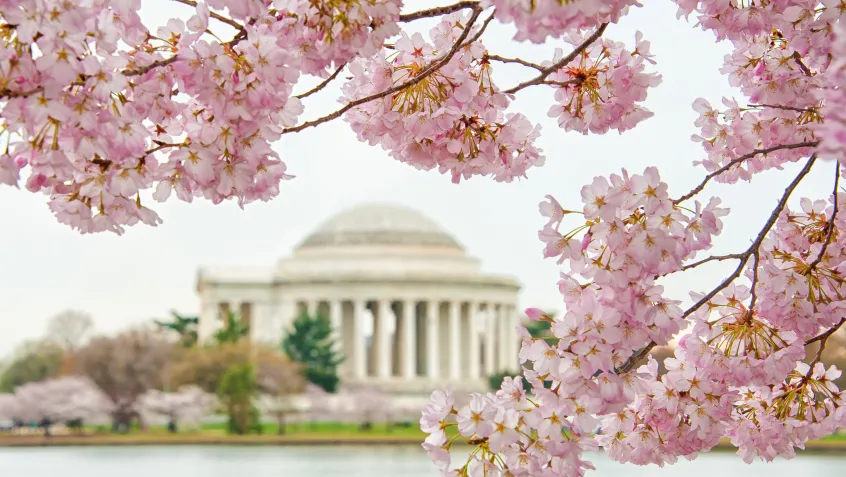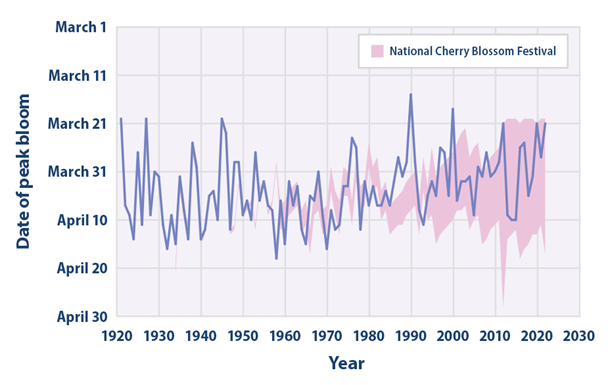
Did You Know?
- In combination with later fall seasons, the length of the growing season in the contiguous 48 states has increased by nearly two weeks since the beginning of the 20th century.
- Changes in growing seasons due to climate change bring health and economic consequences.
- Peak bloom dates for the cherry trees in Washington, DC, have shifted earlier by about seven days since 1921. Climate change is impacting peak bloom and the future of the Tidal Basin.
Growing Seasons Are Changing
Today, many plants and trees are blooming earlier than they did over the past century due to milder winters and earlier spring thaws. In combination with later fall seasons, the length of the growing season in the contiguous 48 states has increased by more than two weeks since the beginning of the 20th century.

The “frost-free season” is defined as the period between the last occurrence of 32°F in the spring and the first occurrence of 32°F in the fall. Over the past 40 years, there has been an increase in the length of the frost-free season over the contiguous United States and Alaska.
The frost-free season can be an important factor in determining the potential growing season. This information helps us understand and anticipate how a changing climate may impact food production, natural resource management, and wildfire risk.

In the US, changes due to climate change present challenges and opportunities for agriculture. Drier conditions and higher temperatures impact plant growth. Earlier bloom times affect entire ecosystems by disrupting plant-pollinator relationships and increasing pest outbreaks. Farmers will likely need to experiment with new crops, varieties, and markets to adapt to a shifting growing season.
Health Impacts of Longer Growing Seasons
More frost-free days and longer growing seasons may sound like a positive, but these changes can make allergy season arrive earlier and stay longer. In fact, a 2020 study found that in North America there is now 21% more pollen in the air an average of 20 days earlier each year compared to 1990. Earlier, harsher allergy seasons can bring serious health impacts that result in more days missed from school and work for those that struggle with asthma.
Earlier thaws bring another health challenge: limited water availability. Mountain snowpacks are natural reservoirs that provide water for millions of people around the world. When snow disappears earlier, it means less water is available for household use or for irrigation and hydropower.
Economic Impacts of Longer Growing Seasons
Droughts are expected to become more common in the US, bringing economic consequences due to wildfire and destroyed crops. Shifting growing and blooming seasons could weaken the plant populations that pollinators like butterflies and honeybees depend on, which would also impact the more than 100 varieties of crops grown in the United States that depend on pollination.
These changes may also impact tourism in some US cities where colorful blooms attract visitors, resulting in additional economic consequences.
The National Cherry Blossom Festival in Washington, DC, which brings more than 1.5 million visitors to the area each year during the peak bloom period for the area’s more than 3,000 cherry trees, provides a good example of how bloom times impact tourism.
The trees were given to the city by Japan in 1912 as a gift of friendship. Their peak bloom date is occurring earlier than it did in the past by approximately seven days, largely driven by local temperatures during the winter and early spring.
Peak Bloom Too Soon?
Based on 102 years of data, the average peak bloom date for cherry blossoms is April 4. While the National Cherry Blossom Festival held each year in celebration of the trees has gotten longer, the cherry trees have bloomed near the beginning of the festival in recent years—and during some years, the festival missed peak bloom entirely.

Climate change also brings another challenge for DC’s cherry trees. Each day, the Tidal Basin rises and falls with approximately 250 million gallons of water from the Potomac River. When the Tidal Basin floods, the brackish water covers the roots of the cherry trees. Salt from the water can weaken and eventually kill a cherry tree. As high tides get higher, the cherry trees provide another reminder about why slowing the rate of sea level rise is so important for coastal communities around the world.
Here’s What You Can Do
Learn more and take steps now to adapt to changing seasons.
- Read NEEF’s climate change and health fact sheet to understand the direct and indirect effects of climate change.
- If you experience asthma, know your triggers and eliminate exposure. Check the Air Quality Index (AQI) often to understand environmental triggers in the air near you. If the AQI is high, limit your outdoor activities. You can prepare for allergy season by starting your medications a little early before symptoms kick in.
- Medical and public health professionals should review NEEF’s Pediatric Asthma Initiative for more information about asthma care and management, including a free eLearning course developed to help pediatric healthcare providers and clinicians manage environmental asthma triggers and intervention strategies.
- Dig deeper into the effects of climate change in our national parks. Science conducted in the parks improves our understanding and provides potential solutions.
- Use this activity guide from NEEF to learn about the pollinators where you live, find out which plants they depend on, and create pollinator-friendly habitats.


